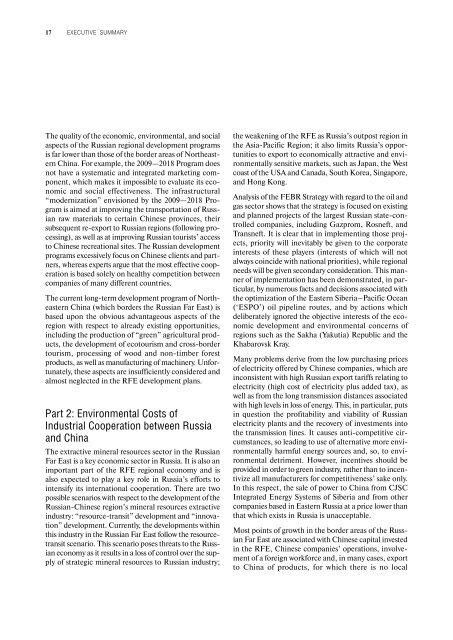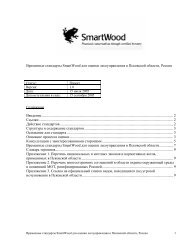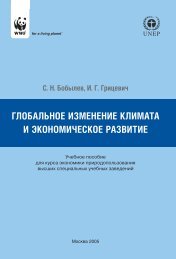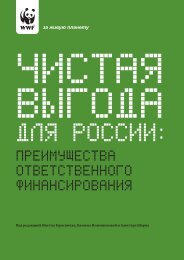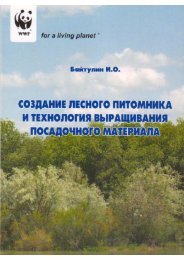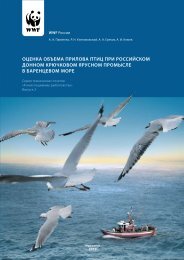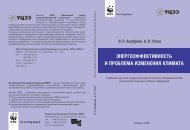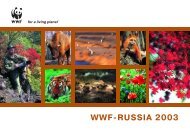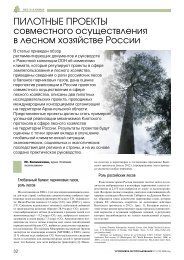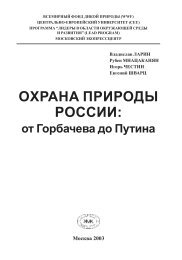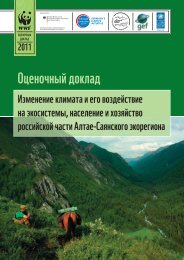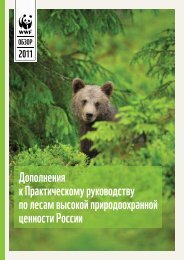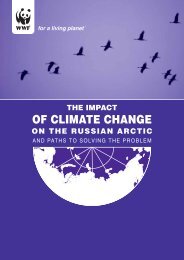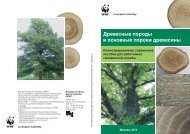to sino- russian
to sino- russian
to sino- russian
You also want an ePaper? Increase the reach of your titles
YUMPU automatically turns print PDFs into web optimized ePapers that Google loves.
17 EXECUTIVE SUMMARY<br />
The quality of the economic, environmental, and social<br />
aspects of the Russian regional development programs<br />
is far lower than those of the border areas of Northeastern<br />
China. For example, the 2009—2018 Program does<br />
not have a systematic and integrated marketing component,<br />
which makes it impossible <strong>to</strong> evaluate its economic<br />
and social effectiveness. The infrastructural<br />
“modernization” envisioned by the 2009—2018 Program<br />
is aimed at improving the transportation of Russian<br />
raw materials <strong>to</strong> certain Chinese provinces, their<br />
subsequent re-export <strong>to</strong> Russian regions (following processing),<br />
as well as at improving Russian <strong>to</strong>urists’ access<br />
<strong>to</strong> Chinese recreational sites. The Russian development<br />
programs excessively focus on Chinese clients and partners,<br />
whereas experts argue that the most effective cooperation<br />
is based solely on healthy competition between<br />
companies of many different countries.<br />
The current long-term development program of Northeastern<br />
China (which borders the Russian Far East) is<br />
based upon the obvious advantageous aspects of the<br />
region with respect <strong>to</strong> already existing opportunities,<br />
including the production of “green” agricultural products,<br />
the development of eco<strong>to</strong>urism and cross-border<br />
<strong>to</strong>urism, processing of wood and non-timber forest<br />
products, as well as manufacturing of machinery. Unfortunately,<br />
these aspects are insufficiently considered and<br />
almost neglected in the RFE development plans.<br />
Part 2: Environmental Costs of<br />
Industrial Cooperation between Russia<br />
and China<br />
The extractive mineral resources sec<strong>to</strong>r in the Russian<br />
Far East is a key economic sec<strong>to</strong>r in Russia. It is also an<br />
important part of the RFE regional economy and is<br />
also expected <strong>to</strong> play a key role in Russia’s efforts <strong>to</strong><br />
intensify its international cooperation. There are two<br />
possible scenarios with respect <strong>to</strong> the development of the<br />
Russian-Chinese region’s mineral resources extractive<br />
industry: “resource-transit” development and “innovation”<br />
development. Currently, the developments within<br />
this industry in the Russian Far East follow the resourcetransit<br />
scenario. This scenario poses threats <strong>to</strong> the Russian<br />
economy as it results in a loss of control over the supply<br />
of strategic mineral resources <strong>to</strong> Russian industry;<br />
the weakening of the RFE as Russia’s outpost region in<br />
the Asia-Pacific Region; it also limits Russia’s opportunities<br />
<strong>to</strong> export <strong>to</strong> economically attractive and environmentally<br />
sensitive markets, such as Japan, the West<br />
coast of the USA and Canada, South Korea, Singapore,<br />
and Hong Kong.<br />
Analysis of the FEBR Strategy with regard <strong>to</strong> the oil and<br />
gas sec<strong>to</strong>r shows that the strategy is focused on existing<br />
and planned projects of the largest Russian state-controlled<br />
companies, including Gazprom, Rosneft, and<br />
Transneft. It is clear that in implementing those projects,<br />
priority will inevitably be given <strong>to</strong> the corporate<br />
interests of these players (interests of which will not<br />
always coincide with national priorities), while regional<br />
needs will be given secondary consideration. This manner<br />
of implementation has been demonstrated, in particular,<br />
by numerous facts and decisions associated with<br />
the optimization of the Eastern Siberia–Pacific Ocean<br />
(‘ESPO’) oil pipeline routes, and by actions which<br />
deliberately ignored the objective interests of the economic<br />
development and environmental concerns of<br />
regions such as the Sakha (Yakutia) Republic and the<br />
Khabarovsk Kray.<br />
Many problems derive from the low purchasing prices<br />
of electricity offered by Chinese companies, which are<br />
inconsistent with high Russian export tariffs relating <strong>to</strong><br />
electricity (high cost of electricity plus added tax), as<br />
well as from the long transmission distances associated<br />
with high levels in loss of energy. This, in particular, puts<br />
in question the profitability and viability of Russian<br />
electricity plants and the recovery of investments in<strong>to</strong><br />
the transmission lines. It causes anti-competitive circumstances,<br />
so leading <strong>to</strong> use of alternative more environmentally<br />
harmful energy sources and, so, <strong>to</strong> environmental<br />
detriment. However, incentives should be<br />
provided in order <strong>to</strong> green industry, rather than <strong>to</strong> incentivize<br />
all manufacturers for competitiveness’ sake only.<br />
In this respect, the sale of power <strong>to</strong> China from CJSC<br />
Integrated Energy Systems of Siberia and from other<br />
companies based in Eastern Russia at a price lower than<br />
that which exists in Russia is unacceptable.<br />
Most points of growth in the border areas of the Russian<br />
Far East are associated with Chinese capital invested<br />
in the RFE, Chinese companies’ operations, involvement<br />
of a foreign workforce and, in many cases, export<br />
<strong>to</strong> China of products, for which there is no local


